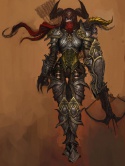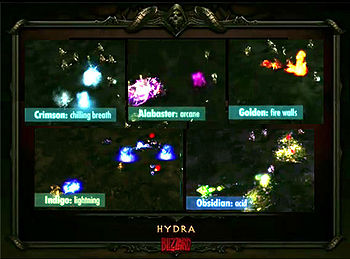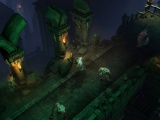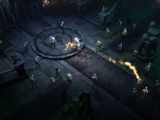Diablo 3 Basics
This is the Diablo 3 Basics page, which is the main Fact Sheet of known Diablo III information. This much-anticipated sequel to Diablo and Diablo II was announced at Blizzard's WWI 2008 in Paris, during 27-28 June, 2008. Regardless if you just heard that Diablo III is announced, or if you have been following some of the Diablo 3 news, this page will get you up to speed!
If you are looking for the Basics Section of the wiki, you can find that in the Basics Category.
Contents
Introduction
Diablo III, while featured completely in 3D with a 3D environment, will follow closely in Diablo II's track by using the classic isometric view, fast gameplay, and randomized content for high replayability. Some changes have been made in order to make the game more welcoming to new players, to ramp up the difficulty more smoothly, and to create a "deep and engaging" combat system. The Diablo III developers took inspiration from previous games in the series, as well as World of Warcraft, and other different games such as Zelda and God of War.
Remember that if you're a newcomer to Diablo, you can find more related articles in the Basics Category
Character Classes
Blizzard confirmed that the game would ship with five characters, then introduced them over the first three years of development. They are the Barbarian, Demon Hunter, Monk, Witch Doctor, and Wizard. All five classes will be playable in male or female versions. The gender difference is purely cosmetic; male and female characters have identical stats and abilities.
The classes are very distinct from one another in look and function. All items of armor have a different appearance on each class (there are even some inter-class gender differences, mainly in the chest armor for obvious reasons). The skills are even more different, with around 25 entirely unique active skills for each class. Many of the passive skills were shared between classes during development, but over time they all differentiated as well.
Though all five classes for Diablo III have been revealed, additional classes will be added in the expansions. See the Other classes article for Blizzard quotes on their additional character ideas.
| Barbarian | ||
|---|---|---|

|

|
The Barbarian - The one returning class is still a mighty brawler, but he's gained countless new tricks, with only a few skills returning, and all of them modified in various ways. |
| Demon Hunter | ||

|
The Demon Hunter - The game's ranged weapon specialist, Demon Hunters are fast-moving archers with devastating offensive capabilities and a wide variety of tactical traps and demonic gadgets. | |
| Monk | ||

|

|
The Monk - The follower of a thousand Gods, Monks from Ivgorod are holy warriors. Combining fast-hitting, melee-ranged martial arts with holy magics, auras, and defensive tactics. |
| Witch Doctor | ||

|

|
The Witch Doctor - A mysterious class from the jungles of Teganze, the Witch Doctor wields a huge array of magical attacks, as well as the ability to mind control enemies and summon up pets to fight alongside him. |
| Wizard | ||

|

|
The Wizard - An evolutionary improvement from the Sorcerer and Sorceress seen in previous Diablo titles. Wizards boast an impressive array of offensive spells that are useful for every situation, as well as defensive spells and escape abilities that combine to create this murderous glass cannon. |
Skills
The skills and their presentation evolved greatly during the game's development, with the largest change coming late in the beta test, shortly before release. See the skill tree article for a full history. Characters can use up to six skills at once, and may cycle between them with only minimal cooldowns.
The biggest change from Diablo 2 comes from the runestone system, which enables every skill to be modified into five different forms, most of which are radically different in function from the base skill. This creates a vast number of possible builds, and with the easy respec system, players can try out all of the skills and rune effects, and switch between them as needed.
Each class has around 25 unique skills, which are unlocked at the rate of about one per level, from level 1 until level 30. Each skill has five rune effects which are unlocked every 5 or 6 levels, thus granting at least one and often three of four new abilities to try out every level up until the maximum level 60.
Passive skills are also unique to each class, and starting at level 10, they are unlocked one every few levels, all the way up to level 60. Characters can have up to 3 passive skills active, adding an additional passive skill slot at level 10, 20, and 30.
Skill Tree Respecs/Resets
In Diablo II prior to v1.13, a character was unable to change their skills and stats once they were allocated. If you made any mistake, the only solution was to reroll. This is changed in Diablo III, and characters can change around their skills as desired, with only minimal cooldowns to prevent this being done exploitatively.
Stats/Attributes
The biggest change to Diablo III attributes is their change to an automatically-allocated system. Players can not set their skill points, and instead gain 1 or 2 points in the four attributes with every level up. The Diablo III developers felt the stat allocation in Diablo II was a poor way to provide character customization since players either experimented and "ruined' their character with sub-optimal choices, or else followed a cookie cutter style of build. (This is less of a problem after v1.13 added stat and skill respecs to Diablo II.)
In the early days of Diablo III, an inventory-like game system called the Talisman was stocked with items called charms, which added large bonuses to stats, but that system was shelved during development. Another system to add specific attributes was the enchants provided by the Mystic, but that system and the Mystic were also removed during development. As a result, players can only modify their stats with equipment bonuses, including those from socketed gems.
The names and function of the stats changed several times during development as well. (See the attributes article for details.) Ironically, after experimentation with up to five attributes, including a system where each attribute granted more or less identical bonuses to each class, the developers returned to the classic four attributes of Strength, Vitality, Dexterity, and Intelligence. The bonuses provided by these four differ considerably from their Diablo II form.
Skill Runes
Another system that underwent numerous changes during development; skill runes were items for most of Diablo III's development. These runes were small objects that were placed in skills, each of which had one socket. Once seated, the runestones changed the function of the skills, always improving them, in five different ways. Those runestones were called crimson, alabaster, indigo, golden, and obsidian.
Though the skill rune effects remained, the item-based runestone system was entirely removed during the beta, and replaced with a system where all of the rune effects are built into skills. They are thus part of the interface, and are "unlocked" one at a time, usually around 5-9 levels apart. Thus a base skill such as the Demon Hunter's Vault is unlocked at level 12, and the rune effects become available one at a time at levels 23, 31, 40, 48, and 53. (Figures subject to yet further change.)
Monsters
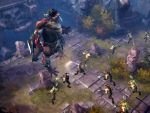
Diablo III has a great array of monsters, which can employ more intelligent behaviour to force players to use strategy during combat. In addition to the random boss encounters the series has made great use of, Diablo III adds numerous "mini-boss" encounters that make for more epic gameplay; an example is the scripted appearance of the Thousand Pounder as seen in the WWI 2008 gameplay movie.
The scale of monsters is greatly increased in Diablo III; demons like the Siegebreaker are not uncommon, and appear in sizes unimagined in previous games in the series.
- The Monsters Article has much more information on the dozens of known monsters.
- Monster bosses are much improved and varied in Diablo III.
- Boss modifiers are new and improved as well, and there are many new and dangerous properties.
Death
Death is less of an obstacle to success in Diablo III than in previous games in the series. Dead players in Diablo III do not lose equipment or gold. They must wait a mere few seconds before waiting to be resurrected by another player in their party or restarting at the last checkpoint (not waypoint) they passed over. In addition, a player will lose a set percentage of their durability upon death (currently 10%) which will need to be repaired either at the Blacksmith or an appropriate vendor.
Hardcore mode is an option in the game, and as in Diablo II, dead HC characters stay dead forever. This will not be the case in the Arena, where Hardcore players will be able to duel as much as they like, without having to create softcore characters just to enjoy the arena fully.
One planned feature that didn't make it into the game were specially gruesome player fatalities, which some bosses were to have the ability to inflict when they killed players.
Difficulty Levels
There are four difficulty levels in Diablo III, Normal, Nightmare, Hell, and Inferno. Each difficulty level repeats the same game content, but with monsters, items, and everything else increased in level to keep scaling up the challenge. Normal is designed to be fairly easy, especially early on, to usher new players into the game and teach them the ropes without too much challenge. Difficulty starts to increase in Nightmare and Hell, and characters should max out at level 60 around the end of Hell. This controversial design choice removes the grinding to max level play system seen in Diablo and Diablo II.
Inferno is where the developers are planning to make things really interesting, with the entire difficulty level vastly harder than Hell, and all balanced to a largely "flat" curve. This should allow players to find challenging and rewarding end game content anywhere in the game, rather than forcing players to run the same few end bosses over and over again, as was the case in Diablo II.
End Game
Diablo III was designed with the end game in mind. The entire Inferno difficulty level is meant as one big PvE end game, with a flat difficulty curve opening up the entire game to high level play. The developers have also considered various systems to reward players for playing normal areas, rather than simply "running" the same few bosses over and over again.
While Inferno is meant to be quite challenging, and best played in co-op parties, nothing in Diablo III is being designed to require parties, such as the raid content seen in WoW. Other end game goodies include special Achievements, crafting recipes and items found only in Inferno, and the possible addition of additional high-end content via patches.
As Diablo III will *not* launch with any form of PvP, the long-anticipated Arena will not serve as an end game activity.
Items

Armor and weapons function much as they did in previous games in the series. Players find low level gear early on, and one of the major goals/enjoyments of playing is to find better quality gear and thus improve your character's performance. One big change to the appearance of armor is the elimination of exception and elite versions of gear. Unlike in Diablo II, Diablo III characters will not find the exact same looking armor repeated on each difficulty level. Instead there are 18 "tiers" of armor, organized into something the developers call gear sets.
Each gear set has a distinctive, organized look, and thus a character wearing all (or most) of say, gear set 14, would have a cohesive, coherent appearance as the items would match each other. The developers have released numerous screenshots of the classes in complete gear sets, and they are stylish indeed. It's less clear, in advance of playing the higher levels, just how often (if ever) a character will have most or all of the same gear set on, or if characters will always be clad in a mixture of different level equipment.
Item quality is similar to that of Diablo II, with item scarcity progressing normal > magical > rare > set > legendary (the new name for unique items). There should be more mixing and matching at the highest levels, with rare, set, and legendary items of approximately-equivalent quality, depending on the random mods they spawn with.
As there are no runes to socket into equipment, there are no runeword items, at least in D3v.
Item Crafting
Crafting returns in Diablo III, in a major game system that combines elements of the item crafting and item gambling systems from Diablo II. Players use the Blacksmith NPC Artisan to create semi-random weapons and armor, including (eventually) set items and legendary items. Each crafted item requires gold and materials, and crafted items all have some pre-set and some random mods, making the item creation a gamble that player may wish to repeat many times, in hopes of spawning an item with better modifiers.
The Blacksmith must first know the recipe to create the item, and these are taught to the Artisans by training them to higher levels, as well as by finding crafting plans, including rare ones, as drops from monsters and chests.
Armor and Weapon Types
- Armor: helms, shields, chest armor, gloves, boots, rings, amulets, and belts return. Belts are now just another piece of armor; they do not have any special potion-holding function.
- New armor types: Shoulders, bracers, and pants.
- New class-specific armor types: Mighty Belts for the Barbarian; Cloaks for the Demon Hunter; Spirit Stones (helms) for the Monk; Voodoo Masks for the Witch Doctor, and Wizard Hats for the Wizard.
- Weapons: Axes, Spears, Polearms, Swords, Maces, Bows, Crossbows, Wands, Shields. (There are no throwing weapons in D3v, and many of these weapon types have class limitations -- Monks can not use bows/xbows, only Wizards and Witch Doctors can use wands, etc. See the individual items pages for full details.)
- New types of weapons: Fists, Daggers (no longer a type of sword).
- New class-specific weapons: Mighty Weapons for Barbarians; Hand Crossbows for the Demon Hunter, Daibos and Fists for the Monk, and Ceremonial Knives for the Witch Doctor.
Other Items Information
- Runes are no longer found in Diablo III. They were never item socketables, but were socketed into skills, until a major system overhaul in early 2012.
- The inventory is much larger than it was in Diablo II, and after numerous permutations, it's settled on a large grid with all items either 1x1 or 1x2 in size.
- The stash in town is large (though it shrunk from 5 to 3 pages during beta testing), and is shared between all characters on the same account. (But not HC and normal characters.)
- All gold and item drops from monsters, chests, quests, etc, are specific to your character. You only see items you can pick up, and do not see items for other characters, nor do they see yours.
- Items dropped by a character are seen by all.
- Trading is supported, both between characters and in a much larger way through the Battle.net Auction House, which has two version, the gold and the real money version.
- Potions are much less common than in previous Diablo games. There are no mana or rejuvenation potions, just health, and they come with a long cooldown between uses. Potions are intended for emergency use only, and players must learn to survive with life leech, hit point regeneration from equipment, and by using the health globes that monsters drop. Successful players must be a bit more cautious than they were in previous games of the series.
NPCs
As in previous games in the series, NPCs will feature importantly in Diablo III. Much of the game story will be given by the NPCs, and they will be more interactive, while their speeches will be shorter, more to the point, and can be listened to while playing; you are no longer forced to "stay awhile" to "listen."
Followers: Diablo III's answer to mercenaries from D2, the followers will have their own skillset and inventory that the player can customize.
Artisans: Are special NPCs who craft items and provide other essential services, as well as much dialogue and information about the game world and quests. They are the Blacksmith and Jeweler, after the Mystic was removed during beta testing.
Locations

The scorching deserts of the Aranoch will be revisited by the player when they have the opportunity to visit one of the largest capital cities in Sanctuary: Caldeum. The player will also explore the depths of the Archives of Zoltun Kulle, ex-horadric mage.
We have been shown detailed pictures of Skovos (the land of the Amazons), as well as Caldeum and Tristram. Skovos is confirmed to be excluded from the game, but the level of detail they are putting into the universe suggests either a big expansion pack, MMOs, or a film. Ureh is another area that has been shown off by the development team (and was showcased in the original cinematic trailer) which will not be in the release version of Diablo III.
Outdoor areas will be less randomized than dungeons, and the terrain will for the most part be static. Instead, a lot of random scripted events will take place, and some will even be really advanced. They can vary from an escort quest, to a moldy tome, or a big, bad boss monster. You will also find interactive environments with dangerous traps, obstacles, and destructible elements. There will be "numerous" outdoor locations. These portions of the map that are randomised are called events, and can even happen within randomised dungeons.
Dungeons
The land is filled with dungeons, as in Diablo II. Dungeons vary widely in size and design, and are promised to offer better randomization and variety than they did in Diablo II. Perhaps more critically, the development team has also stated that there will be many more varieties of dungeons than what was seen in Diablo II.
Dark Berserkers and a Grotesque in the Forgotten Tombs.
Several Walking Corpses.
Witch Doctor who's flameskulling some Walking Corpses.
Transportation
As in Diablo II, travel is on foot. Unlike Diablo II, there is only one movement speed, rather than a walk and run option. This speed can be increased with item mods and some skills, and there is no stamina drain while moving. There are no mounts in Sanctuary, to ride about the world at a higher rate of speed.
The main method of speedy transportation in the game comes from waypoints, of which there are dozens per act, many more than were found in Diablo II. Waypoints are tied to quests and there are multiple waypoints in connected areas, tied to each quest. For instance, a player can only use the waypoint to the start of an area, and then while clearing that area and deeper dungeons within it, additional waypoints will be encountered, for easy returns to town. This allows for more travel without cluttering up the waypoints menu with dozens of them, as well as preventing players from warping right to the end of a quest, Diablo 2 boss run style.
The town portal system evolved repeatedly during Diablo III's development. TPs were in as scrolls, then out entirely, then back in via the Stone of Recall system, then changed back to a town portal activated directly from the belt interface. See those pages for more details.
Easter Eggs
There are numerous small Easter Eggs already seen in Diablo III during the beta testing. These include funny item and monster names, developer names carved on headstones, inside jokes via the Achievements, and more. There are certain to be many other discovered in the full game.
Secret Level?
It seems quite likely that some sort of Secret Level will be found in Diablo III, as an homage to the Secret Cow Level of Diablo II. Numerous hints have been seen, with jokes about rainbows and unicorns abounding in the game and from the developers, much of it spurred by the early art controversy.
Art Changes
Diablo III uses more color, or at least uses color more obviously, than previous games in the series, and this spawned numerous fan debates shortly after the title was revealed in June 2008. The early screenshots and gameplay movies sparked the art controversy and angry online petitions, which Blizzard reacted to by defending their design choices.
- The Art controversy article goes into great detail on this topic.
Story Line

Since the destruction of the Worldstone, those few humans (such as Deckard Cain) who did know of the danger to the world have been expecting an imminent demonic invasion, without the Worldstone to keep them in the Burning Hells. This has not happened because, and players will eventually learn, the two remaining lords of Hell, Belial and Azmodan, have been building armies for a full-on invasion, intended to utterly destroy humanity.
Players will see small-scale demonic events, as in previous games, but the developers have promised that the scale of some aspects of the game, such as the siege on Bastion's Keep, will be amazingly large; far bigger than anything ever previously seen in the series.
Additional information on the story line can be seen within the Black Soulstone Cinematic.
Character Personalities
Unlike the blank cyphers that all characters were in previous games in the series, the individual characters in Diablo III will have personalities. The Wizard is young, brash, and headstrong. The Monk is powerful and quietly confident. The Barbarian is strong and stoic. The Demon Hunter is angry and reckless in her need for vengeance. And the Witch Doctor is spiritual, mysterious, and misunderstood by the populace at large.
The characters will behave accordingly, and inspire different replies and behavior from the NPCs. The Followers such as the Templar and Enchantress each have a distinct personality with a fleshed-out background and will not only banter to the player character, but also to other NPCs (and even to each other within the camp or town). The same holds true for other NPCs, such as Leah, who may on occasion follow the player into the fray during a quest.
Quests
Quests in Diablo III are largely similar in form to those of Diablo II. The changes are to greatly increase the number of quests, and to vary them in type and style, and to create a sense that they were being "played" and not "told about". Numerous smaller events and adventures are spotted throughout the game, many of them randomly-generated each game, to add color and change up the gameplay.
Most large areas of the game, surface and dungeon, will also vary in content and form between games. Though the surface areas are non-random in their overall shape, there are randomized elements within them, which can yield mini-quests, bonus dungeons, or just open space and random monsters, depending on how the spawn works in a given game, which are called either adventures or events, depending upon their magnitude.
Quests can be repeated in Diablo III through the game creation menu.
Single Player and Multiplayer
The main focus of Diablo III is co-op PvE style play. Up to four players (yes, just four) will join up in a game and play together, and players in the same game are now always friendly and in the same party. There is no non-consensual PvP in Diablo III, and no way to "go hostile" in a PvE game. (All PvP takes place in the Arena, a feature that will not be ready for use upon Diablo 3's launch.)
Game creation and group formation will be easier in Diablo III than in the past: it is mostly automated. Diablo III, being on "battle.net 2", is using a match-making system very similar to that which is seen in ladder play in StarCraft II or the dungeon finder in World of WarCraft. A player can choose a few options for their game, including whether or not they want it to be private, and which quest they would like to start on (if they don't wish to simply resume the quest they were last playing). Players can instantly join games in which people on their Friends List are playing.
Diablo III will take place over Battle.net. There is no offline mode: the game is online only. Diablo III is following in Starcraft's footsteps and will not include LAN support. Though Blizzard always claims that this is a benefit, enabling greater player connectedness, most players regard it as an annoyance implemented as a security feature, since all Diablo III play requires players to possess a Battle.net account and valid cd-key.
Battle Arena
All PvP in Diablo III takes place in the Arena. Unfortunately, this feature will not be included when Diablo III ships, as the developers could not get it ready in time for the launch.[1] Players loved the PvP demos at Blizzcon 2010 and 2011, so there are high hopes for this system once it's enabled.
Battle.net 2.0
Battle.net 2.0 for Diablo III includes a Friends List, numerous matchmaking and automatic game joining options, and limited chat channel support.
Other Changes
Among the things that are not listed under their own headline, there are a few other things to highlight about Diablo III:
- Chests will no longer be locked.
- Monster corpses are no longer something that players can interact with. There are no corpse skills like Diablo II's Corpse Explosion or Find Item, and bodies on the ground will vanish after certain criteria have been met. However, dead bodies can be affected by physics.
- There are no player corpses either, in the sense of lootable objects as they were in Diablo II. Like monsters, dead players are subject to the game's physics and can be blasted aside or out of sight by spells, and will vanish after a few minutes.
Release Information
This is a collection of all information available pertaining to the release of Diablo. Including release date, system requirements, beta testing, price/payment methods and age rating.
Release Date
Diablo III will be released on May 15, 2012. This date was revealed on March 15, 2012, after several delays that pushed the initial release window back from the "second half of 2011" and then "early 2012."
- See the release date article for full details.
System Requirements
See the System Requirements article for full details on minimum and recommended system specs for PC and Mac.
Windows Minimum Requirements:
|
Mac Minimum Requirements
|
|
PC Recommended System Requirements
|
Mac Recommended System Requirements
|
Diablo Beta Testing
The Diablo 3 beta test began in early September, 2011, and continued through the end of the year and into 2012. The frequency of patches and number of beta testers increased dramatically in early 2012, as the game neared completion and balancing changes grew more frequent. The beta test is expected to continue until a week or two before the release on May 15, 2012.
Prior to the start of the test, the developers had repeatedly said it would be a quick beta test, devoted largely to technical issues and Battle.net stress testing. That turned out to be very untrue.
Retail Price
The retail price for Diablo III is variable by region. It will be a "boxed" retail product (no monthly fees, just a one-off price) and priced similar to other AAA titles. Starcraft II (and other recent AAA titles by Activision) retailed for $60 USD, up $10 from the traditional $50 price tag, and it's virtually certain Diablo III will follow that route. Any pre-order for the game, currently, follows this trend.
The Collector's Edition of the game is retailing for $100 USD, plus any applicable taxes or service fees.
Game Age Rating
The rating of Diablo III is estimated to be aimed for gamers above the age of 15, while still trying to avoid USK 18+ in Germany, or other similar ratings that would hamper the sales of the game in that country. Blizzard have stated that they will censor out blood and other gore, as required to avoid "adult" ratings in various countries with more restrictive gore requirements than those found in the US.
- America (ERSB) - "M" Mature Rating (player should be at least 17 years old). No law enforcement.
- Europe (PEGI) - 16+ (player should be at least 16 years old). No law enforcement (for most countries).
- Germany (USK) - USK 16+ (player should be at least 16 years old). Law enforcement of USK.
- Read more in the ratings article.
Copy Protection and DRM
It's unknown what type of copy protection (DRM) will be used on Diablo III, but with the new Battle.net changes and new Battle.net accounts, the game will likely only use a very light form of copy protection since the license is associated with the account. There is no offline play, and the odds of Blizzard requiring a player to have the disc in the drive is exceedingly minimal.
Blizzard hasn't bothered with much copy protection in the past, and will likely not bother with it at all in the future, in lieu of bringing their games completely onto battle.net. The only "piracy" that can occur in such a system is an emulation of the server, which makes for a pale imitation of the actual game. Once a player ties a game to their battle.net account, they can then download the game to install on their local machine at any point in time as well, circumventing the need for physical media, such as discs.
Who's in Charge?
Naturally, Blizzard Entertainment are the guys making Diablo III, but that isn't a surprise. The important people for this production is the relatively new Blizzard employee Diablo III Lead Designer Jay Wilson, besides the regular team. For fans, you might want to keep a look out for Bashiok, the new Diablo Community Manager and Leonard Boyarsky who is the Lead World Designer for Diablo III, and head of quests & lore as well as designing the world of Sanctuary.
- See the D3 Team article for info on dozens of Diablo III's developers.
Expansions, MMO or Diablo Movie
Whatever will come after Diablo III is unknown, but it seems apparent that Blizzard is confident [2] that there WILL be expansions. They have mentioned that the story line will have a more "final" ending than in Diablo II, which possibly means making it better for an expansion, or perhaps a future MMO or a Diablo movie. Regardless, Jay Wilson has said that there is lots of potential for expanding the universe. What types of media this will come in is unknown: books, comics, manga, expansions, games or a movie...
Mike Morhaime said they would like to make Diablo III expansions annually[3], and confirming plans for multiple expansions for the game.
Further Information
You can follow the links to each specific section for further details on Diablo III development and information. You can also use one of the following links for further information:
- Diablo III news - The most coherent news listing for Diablo III.
- Media Coverage - All Interviews, Previews, Pictures, Videos and Articles from around the web.
- Diablo III Basics - A listing of articles with good information if you are new to Diablo III.
- Diablo III FAQ - Frequently Asked Questions
- Diablo 3 History - The history of Diablo III up until the announcement.

